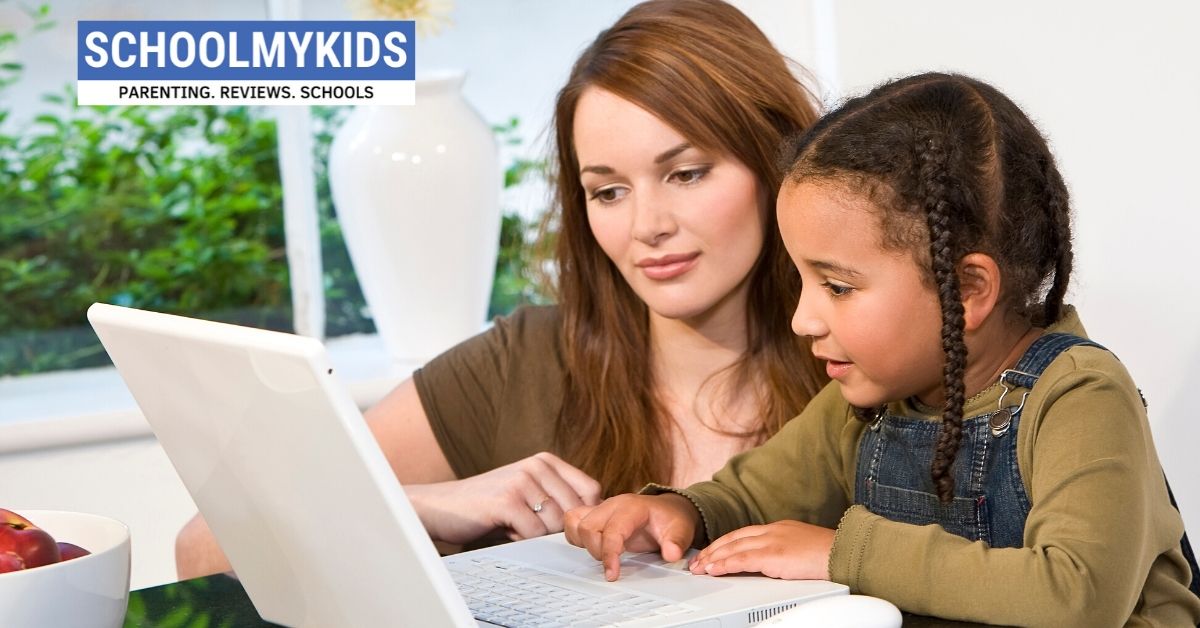Drew Barrymore, the Hollywood actress, and mother of 2, recently said about her own challenges teaching her kids from home, “I didn’t think I needed to respect and appreciate teachers more than I did.” I know I feel the same way. And I’m guessing many parents who are homeschooling their kids for the first time, do too.
Just yesterday, when my daughter complained about doing her school assignment, I reminded her that staying at home is not a vacation! The question for many of us, how do we create an environment conducive to learning at home, while also supporting our kids’ ongoing education. Below are 12 tips to help you through the process of homeschooling your kids during this COVID-19 lockdown.
12 Tips to Support Kids at Home
Tip #1 Create a Structure and Routine
The first tip to supporting our kids’ online education at home is to create a structure and routine for them to follow. Our kids’ lives at school are set to a school bell. While I’m not suggesting you need to ring a bell at the start of the day (though if that helps why not), starting a period of academic study at the same time every day will help. When creating a structure, consider the attention span of your child. For 4 to 5-year-olds, experts say you can expect your kids to focus on average from 4 to 20 minutes. So be creative in mixing up activities, you may need to mix up a 15-minute math practice sheet, with a 20-minute art activity. Also, set regular times for lunch, snacks, nap, exercise, free play, recess, whatever helps not only your child but also you be aware of what’s happening next.
Tip #2 Create a Workspace
Creating a workspace is also a great tip if you are working from home. We all need a quiet space, free of distractions and clutter, to help us concentrate. In addition, make sure the workspace has plenty of light. Also, have a box of school supplies, so there’s easy setup and clean up after academic time. Last, because most students move around during the day at school, it’s ok to have more than one designated workspace. While you want to be safe and not have too many distractions, consider finding a space close to a big window or outside where they can work.
Tip #3 Know Your Kid
No one knows your kid better than you do. Some kids may actually thrive working on their own, while others will terribly miss the social aspect of learning. If your kid works better in groups, consider setting up a regular Zoom session with 3 or 4 friends so they can do their homework assignments better. That can get complicated for young kids, so having a few set times to visit with friends through Zoom, and then getting back to the homework alone might be best.
What kind of learner is your kid: visual, auditory, reading/writing, or kinesthetic? Does your child need help getting started on an assignment? Does your kid work better in the mornings or later in the day? These are the kinds of questions you may want to consider when setting up your schedule and helping with assignments.
From what I can tell at this point, because our daughter loves to read and write, she’s this type of learner. While she doesn’t necessarily need help to get started, she prefers if one of us is within close proximity while she works. She’s also like me, once breakfast is finished, she’s ready to roll.
Tip #4 Remove Distractions
I’m guessing all of us understand why this tip is essential. Here are a few points I’ve found helpful:
- Walk through your house, think through what distracts your kid, then make a list of the distractions you will need to remove.
- During designated study times, screen time is only for lessons.
- If you have indoor pets, move them to another room.
- Consider turning off your mobile phone or taking calls in another room.
- Download assignments and then turn off the Wi-Fi.
While the following won’t suit everyone, we use the following strategy to help us balance screen time. For every activity, a chore, assignment, or period of practice, our daughter completes, she ‘earns’ 5 minutes of screen time.
Tip #5 Mix Screen Time with Traditional Learning Materials
While turning to tablets and laptops is inevitable, there are a lot of reasons to limit the amount of time we expose our kids to screens. Consider mixing up the medium: if they are completing their assignments, or if most of their work is online, make reading a book of their choice a thirty-minute activity they do every day. Our family is currently enjoying reading a chapter of Charlotte’s Web every day.
Tip #6 Don’t Get Overwhelmed by Online Resources
This is an important tip for me, and more than likely, any parent who has gone online looking for educational resources and activities. My advice is, when you find a resource that’s working for you, stick to it. Find two, three, maybe four resources, then stop. For example, Scholastics online learning, Cosmic Kids Yoga, and KIDDOpia are three of our go-to resources, in addition to our daughter’s schoolwork. When you throw in meals, exercise, practicing piano, and gymnastics, we have a full week of activities. While I think it’s a good idea to spend a few minutes each week looking around for an upgrade or checking out a tip from a friend, there are so many suggestions from my WhatsApp groups that I often skip over those messages.
Tip #7 Let the Kids Choose
I love this tip. This is an especially great tip for older students, but can also be used with younger kids. What does your kid love to do? Do they love art, do they enjoy cooking, do they love making music, creative writing, or gardening? Check out my blog on why it’s important to provide choices Giving Kids Choices. Don’t worry, you’re in control. While playing video games would not be a viable option, perhaps building a website is!
Tip #8 Sleep
When it comes to this tip, there are many opinions. Some experts suggest keeping your same, pre-pandemic routine and go to bed and wake up at your regular times. While other experts suggest it is ok if we let our kids sleep in a bit. One piece of advice I read, which fits under the “Know Your Kid” tip, is if you are raising a teenager, letting them sleep in. Beginning their academic study time later in the day might allow you to take advantage of the studies that suggest teenagers are sharper in the afternoon and evening. Our general rule is as long as our daughter is getting her 8 to 10 hours a night, we’re ok if she stays up and sleeps a bit later in the morning.
Tip #9 Set Yourself a Goal of 2 to 4 Hours
This tip helped me put into perspective my expectations for the amount of time my daughter is engaged in academic-related activities. A goal of two to four hours of uninterrupted, academic study is likely the same amount of time our kids are really engaged when at school. Most families who home-school their children don’t plan 7 hours of work. When you consider the time set aside for lunch, recess, transitioning between classes, nap time for younger students, and a realistic attention span based on the age of your child, this makes a lot of sense to me. My daughter is almost six years old, so I would adjust depending on the age of your child.
Tip #10 Exercise
This is another essential tip for kids and parents, we must find ways to keep moving even if we are stuck at home. The benefits of exercise are many:
- Strengthens the heart, lungs, and bones.
- Reduces blood sugar, controls weight, and lowers blood pressure.
- Reduces stress, improves energy levels, and we just feel better.
- Enhances academic performance, cognitive skills, and academic behavior.
When you’re creating your daily schedule, be sure to include time for exercise for everyone!
Tip #11 Video Chat with Friends
This tip is important. Most kids are social and miss their friends. Our daughter, at this point, will Skype or FaceTime with a classmate, a cousin, or her Didi every two or three days. While our instinct might be to Skype classmates for academic work, be sure to include time during the week just for the kids to connect socially without any alternative motives. Depending on your rules, if you have teenagers, when the homework is finished, let them have some online game time with their friends too.
Tip #12 Keep in Touch with Other Parents and Teachers
This last tip is vital. While we don’t want our kids to feel isolated from their classmates, we also need to be careful not to isolate ourselves. We also need friends. We need to hear from other parents what’s working well and what’s not. We need to know we aren’t the only ones struggling. We also need to hear what other parents are doing and share what we are doing. Same with the teachers. Share any challenges you are having with keeping your kid’s attention or motivating them to work. Chances are the teacher has already experienced these challenges with your kid and might possibly have a few strategies he or she has used.
This Isn’t Easy, Don’t Panic
This Coronavirus Pandemic is a scary situation and a stressful time. Most of us have never homeschooled our kids before. Except for academic breaks, most of us haven’t spent this much time with our kids since they started school. Some days, you might need to put on a movie to get through a rough day, and that’s ok. In fact, an education coach for students in California suggests, “You don’t have to home school if it’s really going to cause severe emotional distress for everyone involved. And I think that’s really important for parents to hear right now because we all feel so much pressure.” So please take it easy. Don’t isolate. Reach out when you need help, advice, or you just need someone to listen. Our kids will catch up academically, let that go. During a time like this, your and our kids’ long-term, emotional well-being is far more important than completing a homework assignment or worrying about what they are missing.






